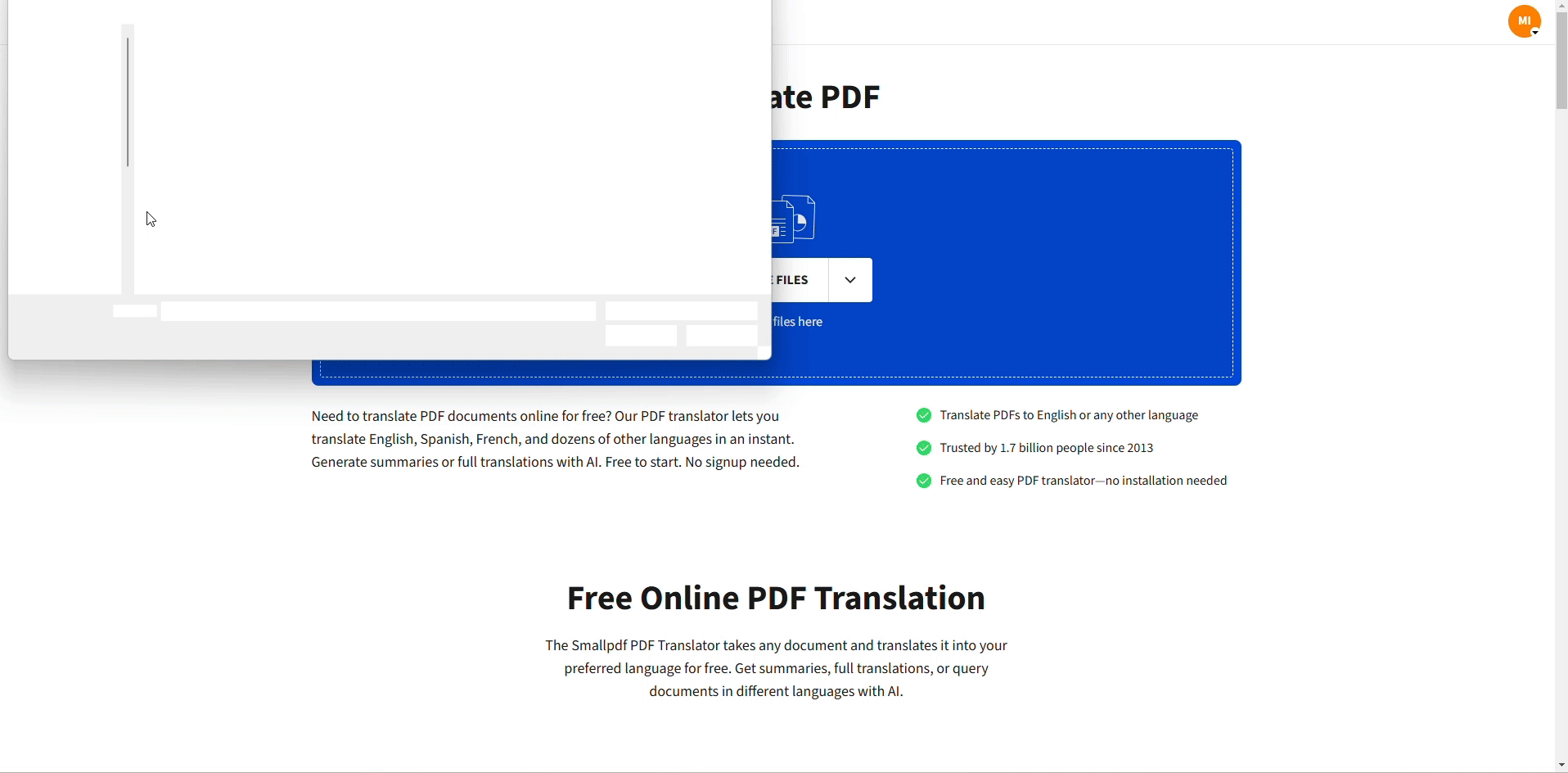
Struggling with scanned PDF translations? Learn how OCR technology and the right tools can turn gibberish into accurate translations quickly.
Translating scanned PDFs can be a frustrating process, especially when errors or formatting issues derail your project.
Have you struggled with unreadable text, gibberish translations, or tools that refuse to process your file? If so, you’re not alone—scanned PDFs introduce unique challenges for translation. But the good news is, these challenges are solvable with the right tools and techniques.
In this guide, we’ll show you how to overcome these common problems with translating scanned PDFs and share practical solutions to help you get it done quickly and easily.
Quick Steps to Translate a Scanned PDF Fast
If your scanned PDF isn’t translating properly, use this workflow: 1. Open Translate PDF on Smallpdf. 2. Upload your scanned PDF. The tool runs OCR automatically to turn images into readable text. 3. Pick your languages and choose a full translation or a summary. 4. Download the translated file or open it in another Smallpdf tool for small layout fixes.
For files that are too large or have heavy formatting, convert the scan to Word first with PDF to Word, adjust the layout, and then translate it.
Why Translating a Scanned PDF Requires OCR (And What That Means)
Here’s the thing about scanned PDFs—they’re not actually text documents. They’re images of text, which means your computer sees them as pictures, not words you can select or copy.
That’s where Optical Character Recognition (OCR) comes in. OCR is technology that “reads” text from images and converts it into actual, editable text that translation tools can work with.
Here’s the key difference:
- Digital PDF: Text you can highlight, copy, and search through
- Scanned PDF: A photo of a document—no selectable text
Without OCR, trying to translate a scanned PDF is like asking someone to translate a photograph of a book. It just doesn’t work. But with OCR? Your scanned document becomes as translatable as any digital file.
How to Translate a Scanned PDF with Smallpdf (Step-by-Step)
- Visit Translate PDF.
- Drag and drop your file into the tool or click to upload it from your device.
- The built-in OCR will convert the scanned text into editable content.
- Choose whether you want a summary or a full document translation.
- Specify the source and target languages for translation.
- Within seconds, your scanned document will be translated into your preferred language.
- Review and make any adjustments before saving the translated file.

How to Translate a Scanned PDF
Pro Tips to Improve OCR Accuracy
Want better translation results? Start with a cleaner scan:
- Scan at 300 DPI minimum for crisp text recognition.
- Remove watermarks or stamps that might confuse the OCR.
- Increase contrast if the text looks faded.
- Straighten crooked pages before scanning.
When to Convert to Word First
Sometimes converting your scanned PDF to Word before translation gives you more control over formatting. This works especially well for documents with complex layouts or when you need to make manual edits after translation.
Features That Matter When You Translate a Scanned PDF
Not all PDF translation tools are created equal. Here’s what makes the difference when you’re working with scanned documents:
Built-in OCR for Image-Based PDFs
The best tools handle OCR automatically—no manual text extraction needed. Smallpdf’s built-in OCR instantly recognizes text in scanned documents and converts it into editable text, ready for accurate translation.
Layout and Formatting Preservation
Your translated document should look like your original. Quality tools preserve fonts, images, tables, and overall layout so your translated PDF stays professional and readable.
Security and Privacy (GDPR, ISO, TLS)
Translating sensitive documents? Look for ISO certification, GDPR compliance, and 256-bit TLS encryption. Smallpdf meets all these standards to keep your files secure.
Translate at Scale (Large Files, Multiple Files)
Need to handle big projects? The right tool supports large file sizes and batch processing. Upload multiple scanned PDFs and translate them simultaneously to save time and effort.
Work Anywhere (Web, Desktop, Mobile)
Access your translation tools from any device—browser, desktop app, or mobile. No software installation required.
Translate Other File Formats
Beyond PDFs, quality tools also handle Word documents, PowerPoint presentations, and other common file types in the same workflow.
Common Scanned PDF Translation Problems (And Quick Fixes)
Here are the most frequent issues people run into—and how to solve them fast:
Your PDF Is Too Large to Translate Online
Many online tools have size limits, often restricting uploads to under 10MB or 300 pages. If your PDF file exceeds these limits, the translation simply won’t happen.
- Solution 1: Use the Smallpdf PDF Translator, which works seamlessly with large PDF files. You can translate lengthy documents without worrying about file size restrictions. Just upload your document and translate it instantly into any language with no hassle.
- Solution 2: For extremely long PDFs that not even Smallpdf’s translator could handle, cut the PDF into more manageable chunks using Split PDF.
Your Scanned PDF Translates into Gibberish
Scanned PDFs are essentially image files. Without Optical Character Recognition (OCR) to convert the image into editable text, translating these files often produces gibberish.
- Solution: Smallpdf’s built-in OCR instantly recognizes text in scanned documents and converts it into editable text, ready for accurate translation. Once your file is processed, you can translate it into your preferred language with ease.
Formatting Issues Render the Translation Unusable
Does the translated text overlap images or scramble the layout of your document? This is a common issue when using free tools like Google Translate, which don’t preserve your original formatting.
- Solution: Smallpdf’s PDF Translator ensures text is structured properly. While it might not carry over every design detail, it preserves the core layout, helping your document remain readable after translation.
You Hit a Word or Character Limit
Some translation platforms have limits on the number of words or characters you can translate at once, disrupting your workflow.
- Solution: Smallpdf offers generous limits in terms of file size and number of pages, making it easy to handle larger projects. For dense text, the tool can even generate summaries, so you can quickly skim key points in your preferred language.
You Don’t Know How to Convert a Scanned PDF
Sometimes, converting scanned PDFs into another format (e.g., Word) before translating can simplify the process and give better results. However, many people don’t know how to do this.
- Solution: Use PDF to Word to easily convert the file. Once it’s in Word, translation and formatting become more manageable. You can always convert it back to PDF once editing is complete.
Need to Translate Multiple PDFs at Once
If your project includes several files, translating them one by one is time-consuming.
- Solution: Use Smallpdf’s batch file translation feature. Upload multiple scanned PDFs and translate them simultaneously to save time and effort.

Translate Multiple PDFs at Once
Concerns About Document Security
Security becomes a top priority if your PDFs contain sensitive information. Sending them to free, unsecured translation tools can be risky.
- Solution: Smallpdf is ISO-certified and GDPR-compliant. With 256-bit TLS encryption, your uploaded and translated files remain private and secure, giving you peace of mind.
Translate a Scanned PDF for Free with Smallpdf
Ready to translate your scanned PDF? Try Smallpdf free—no signup required for your first translation. Our built-in OCR handles the text extraction automatically, and you can translate into dozens of languages with formatting intact.
Whether it’s a single page or a multi-page document, get started in seconds and see why millions trust Smallpdf for their document needs.
FAQs About Translating Scanned PDFs
Is there a way to translate a scanned PDF?
Yes! You need a tool that combines OCR (Optical Character Recognition) with translation. The OCR first converts the scanned image into readable text, then the translation engine converts it to your target language. Smallpdf’s PDF Translator handles both steps automatically.
Can I translate a scanned PDF for free?
Yes, you can use Smallpdf’s free tier to translate scanned PDFs. The built-in OCR and translation work without requiring a subscription, though there are some limits on file size and monthly usage for free accounts.
Can I translate an entire PDF document at once?
Absolutely! Smallpdf can translate entire PDF documents in one go, regardless of length. The tool processes all pages simultaneously, maintaining the original layout and structure throughout the document.
Can ChatGPT translate a scanned PDF?
ChatGPT can’t directly process scanned PDFs since it can’t “see” the text in image files. However, Smallpdf’s AI-powered translator can handle scanned documents by using OCR to extract text first, then applying advanced translation algorithms.
How do I keep the formatting when I translate a scanned PDF?
Smallpdf’s translator preserves the core layout and structure of your PDF during translation. While some minor formatting adjustments might occur, the document remains professional and readable. For maximum formatting control, you can also convert to Word first, translate, then convert back to PDF.



